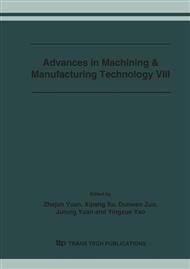p.25
p.30
p.35
p.40
p.45
p.51
p.56
p.61
p.66
Experimental Study on Green Cutting with Water Vapor as Coolant and Lubricant
Abstract:
Green cutting has become focus of attention in ecological and environmental protection. Water vapor is cheap, pollution-free and eco-friendly. Therefore water vapor is a good and economical coolant and lubricant. Water vapor generator and vapor feeding system are developed to generate and feed water vapor. The lubricating method of water vapor is that the water vapor jet flow is directly jetted on the cutting zone and it cancels the fluid phase penetrating the capillaries in cutting zone. So it increases the time reserve of penetration and improves the property of penetration and lubricating effect. In order to find the influenced disciplinarians on lubricating effect with nozzle diameter, the parameters of water vapor jet flow and cooling distance (the distance between nozzle and cutting zone), experiments are carried out which hard alloy YT15 (P10 type in ISO) tool is used in cutting C45 steel. Experimental results show that the cutting force becomes lowered and chip thickness becomes thinned with the nozzle diameter decreasing. With the saturated vapor pressure increasing and the cooling distance shortening, the cutting force is lowed and the chip thickness is thinned too. Therefore the application of water vapor as coolant and lubricant can realize the green cutting in industry.
Info:
Periodical:
Pages:
45-50
Citation:
Online since:
July 2006
Authors:
Keywords:
Price:
Сopyright:
© 2006 Trans Tech Publications Ltd. All Rights Reserved
Share:
Citation:


